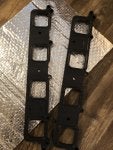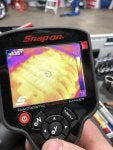Wanted to update everyone on the Forced Induction Interchillers blower spacer / thermal blanket testing we did Friday here in Colorado, and let you know about a deal I was able to broker with FI for Hellcat, Trackhawk, Redeye, et al., owners.
First, about the testing: The raw number gains, without a tune adjustment, on my setup -- 2.5 upper / 10 ATI -- amounted to 37 WHP, 40f degree temp decrease on the SC surface, and 20f degree decrease on the MAP sensor. So a cooler blower, cooler fluids, lower IATs, and lower surface temps are all attributable to the spacer and thermal blanket combination. IATs dropped about 9-10f degrees with the spacers and blanket fitted.
We also saw a gain in boost -- or rather, we recovered boost that was being lost to an OEM intake gasket that doesn't have full metal supports all around the rubber, has an open oil gallery, and is susceptible to breach and oil blow by. From the logs, we learned that I was losing about 2.7% of my boost, roughly 3/4 of a lb; because I'm at altitude and we struggle to find boost, there's a possibility the loss is going to be even worse in cars closer to sea level.
From this boost regain, we can fairly infer that the WHP gains were at least partially due to boost going into the combustion chamber instead of into the crank case.
I sent the logs off to Curt@Injected and he has since done a revision, adding some fuel (for trims) and 1.5 degrees timing. I'll dyno it again with the tune as a baseline at the time I install the interchiller system, so we can see gains from the non-tuned test to the re-tuned test, and then final gains after the interchiller and tank are installed.
Just a crude guess based on a rudimentary 10 WHP for 1 degree of timing metric, but it looks like the overall gains from the spacer and blower once tuned will be roughly 50-55 WHP on my car.
I think we'll see a kind of "gains curve" with these units. Here's something to consider: because I'm running a 2.5 upper, I'm obviously spinning the blower faster than someone who is running a 2.75, for example. So the amount of cooling you get is likely to be proportional to the amount of heat you're putting out. This could impact the amount of WHP you see added.
As I've said elsewhere, though -- and will repeat here -- the rewards are the same regardless of your specific configuration: you're cooling your SC and intercooler (so you'll be stressing your components less); you're cooling your MAP sensor (so you're getting truer IAT readings, which is beneficial in tuning / monitoring your temps at the track); you're gaining WHP; and -- most importantly, in my opinion -- you are fixing a design flaw by replacing an intake gasket carried over from an N/A platform that lacks support in a certain area and has an opening to an oil gallery (where breached boost will pressurize your crank case, and oil blow by can get into your SC) with a far sturdier billet kit that physically blocks boost breach and oil blow by.
More, that pressure in the crank case is forcing the pistons to work against themselves. Removing that pressure should lead to quicker acceleration -- something Cody Chapman really felt in a seat-of-the-pants way on that third pull.
A blanket alone will obviously provide some heat relief. But it wouldn't provide as much because the physical spacing between the cylinder heads and blower would be 10-11mm closer than it is with the spacers installed. The spacers' material is another layer of heat reduction. And without the spacers, the distance from the cylinder heads to the MAP sensor is mostly unaffected -- so you lose the benefit of being able to read cooler IATs thanks to a sensor that is not quite so heat soaked.
Additionally, my test with the velocity stack added to my Bwoody intake suggests to me that a cooler SC / MAP sensor, aided both by the spacers and the thermal blanket keeping radiant heat from entering the SC belly, allows other components to reach their potential.
I very much doubt Bwoody would advertise the kinds of gains I saw from the velocity stack. But then, they designed it with the stock blower in mind.
Curt@Injected was surprised and impressed by the gains. When my tuner and mechanic are happily surprised, I figure I've done something right, and that I should share it with other enthusiasts.
In my build, no new belt was required. The only other install I know of so far is on a Trackhawk. That was running a 2.75 upper and also didn't need a new belt. In most instances, you probably won't -- but it's going to depend on how much slack you have in your current belt.
Photos attached show the 3 pulls with no tune adjustment: baseline, spacers/blanket, spacers/blanket/velocity stack. All 3 runs were done under nearly identical conditions (hottest Engine temp was 186 on run 2, a few degrees hotter than the baseline run).
Kirk did a summary of the findings based on his review of the logs. Those interested can read that here: https://www.hellcat.org/threads/intake-spacers-redux-and-follow-up.225565/page-7#post-4029733
Right now, I am putting together a group buy for those interested. If I can get 20 people to commit, I can get you each a decent discount from the new batch that is going into production next week. I have 13 people already committed, so please let me know asap. The kit comes with the billet composite spacers, the thermal blanket, and 12.9 rated longer bolts (torque specs are the same as factory).
Normal price on these is $650 AUS, or about $465 US, plus currency conversion fees. If we can reach the 20-person pre-order target for the new batch, you can probably save about $30-$40 and I'll drop ship the kit to you through USPS Priority at no extra charge. If you are interested, let me know, either below or through PM.
Next batch will be ready next week, so delivery would be about a week to 2 weeks out.
If you have any questions, don't hesitate to ask.
First, about the testing: The raw number gains, without a tune adjustment, on my setup -- 2.5 upper / 10 ATI -- amounted to 37 WHP, 40f degree temp decrease on the SC surface, and 20f degree decrease on the MAP sensor. So a cooler blower, cooler fluids, lower IATs, and lower surface temps are all attributable to the spacer and thermal blanket combination. IATs dropped about 9-10f degrees with the spacers and blanket fitted.
We also saw a gain in boost -- or rather, we recovered boost that was being lost to an OEM intake gasket that doesn't have full metal supports all around the rubber, has an open oil gallery, and is susceptible to breach and oil blow by. From the logs, we learned that I was losing about 2.7% of my boost, roughly 3/4 of a lb; because I'm at altitude and we struggle to find boost, there's a possibility the loss is going to be even worse in cars closer to sea level.
From this boost regain, we can fairly infer that the WHP gains were at least partially due to boost going into the combustion chamber instead of into the crank case.
I sent the logs off to Curt@Injected and he has since done a revision, adding some fuel (for trims) and 1.5 degrees timing. I'll dyno it again with the tune as a baseline at the time I install the interchiller system, so we can see gains from the non-tuned test to the re-tuned test, and then final gains after the interchiller and tank are installed.
Just a crude guess based on a rudimentary 10 WHP for 1 degree of timing metric, but it looks like the overall gains from the spacer and blower once tuned will be roughly 50-55 WHP on my car.
I think we'll see a kind of "gains curve" with these units. Here's something to consider: because I'm running a 2.5 upper, I'm obviously spinning the blower faster than someone who is running a 2.75, for example. So the amount of cooling you get is likely to be proportional to the amount of heat you're putting out. This could impact the amount of WHP you see added.
As I've said elsewhere, though -- and will repeat here -- the rewards are the same regardless of your specific configuration: you're cooling your SC and intercooler (so you'll be stressing your components less); you're cooling your MAP sensor (so you're getting truer IAT readings, which is beneficial in tuning / monitoring your temps at the track); you're gaining WHP; and -- most importantly, in my opinion -- you are fixing a design flaw by replacing an intake gasket carried over from an N/A platform that lacks support in a certain area and has an opening to an oil gallery (where breached boost will pressurize your crank case, and oil blow by can get into your SC) with a far sturdier billet kit that physically blocks boost breach and oil blow by.
More, that pressure in the crank case is forcing the pistons to work against themselves. Removing that pressure should lead to quicker acceleration -- something Cody Chapman really felt in a seat-of-the-pants way on that third pull.
A blanket alone will obviously provide some heat relief. But it wouldn't provide as much because the physical spacing between the cylinder heads and blower would be 10-11mm closer than it is with the spacers installed. The spacers' material is another layer of heat reduction. And without the spacers, the distance from the cylinder heads to the MAP sensor is mostly unaffected -- so you lose the benefit of being able to read cooler IATs thanks to a sensor that is not quite so heat soaked.
Additionally, my test with the velocity stack added to my Bwoody intake suggests to me that a cooler SC / MAP sensor, aided both by the spacers and the thermal blanket keeping radiant heat from entering the SC belly, allows other components to reach their potential.
I very much doubt Bwoody would advertise the kinds of gains I saw from the velocity stack. But then, they designed it with the stock blower in mind.
Curt@Injected was surprised and impressed by the gains. When my tuner and mechanic are happily surprised, I figure I've done something right, and that I should share it with other enthusiasts.
In my build, no new belt was required. The only other install I know of so far is on a Trackhawk. That was running a 2.75 upper and also didn't need a new belt. In most instances, you probably won't -- but it's going to depend on how much slack you have in your current belt.
Photos attached show the 3 pulls with no tune adjustment: baseline, spacers/blanket, spacers/blanket/velocity stack. All 3 runs were done under nearly identical conditions (hottest Engine temp was 186 on run 2, a few degrees hotter than the baseline run).
Kirk did a summary of the findings based on his review of the logs. Those interested can read that here: https://www.hellcat.org/threads/intake-spacers-redux-and-follow-up.225565/page-7#post-4029733
Right now, I am putting together a group buy for those interested. If I can get 20 people to commit, I can get you each a decent discount from the new batch that is going into production next week. I have 13 people already committed, so please let me know asap. The kit comes with the billet composite spacers, the thermal blanket, and 12.9 rated longer bolts (torque specs are the same as factory).
Normal price on these is $650 AUS, or about $465 US, plus currency conversion fees. If we can reach the 20-person pre-order target for the new batch, you can probably save about $30-$40 and I'll drop ship the kit to you through USPS Priority at no extra charge. If you are interested, let me know, either below or through PM.
Next batch will be ready next week, so delivery would be about a week to 2 weeks out.
If you have any questions, don't hesitate to ask.










